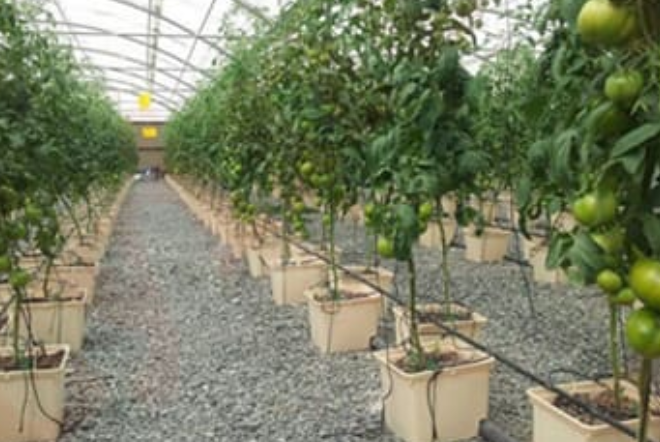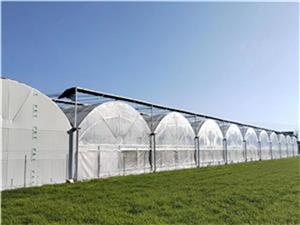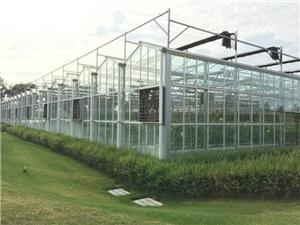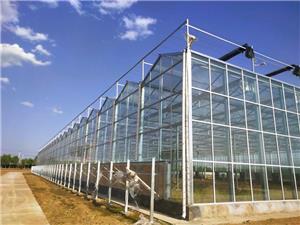What are the effects of light on tomatoes and cucumbers?
In modern agricultural production, agricultural greenhouses, with their controllable environmental conditions, have become the core carriers for the efficient cultivation of economic crops such as tomatoes and cucumbers. Among them, light, as the energy source for photosynthesis in crops, directly determines the growth rate, yield and quality of tomatoes and cucumbers. Especially in tomato greenhouses, precise light environment management is the key to achieving high-quality and high-yield tomatoes. This article will deeply analyze the specific impacts of light on tomatoes and cucumbers from three dimensions: light duration, light intensity, and light spectrum composition, providing scientific light regulation ideas for agricultural greenhouse growers.
I. Duration of Light Exposure: The Foundation for the Growth Cycle and Fruit Production Efficiency of Tomatoes and Cucumbers
The duration of light exposure refers to the time crops receive light each day. In agricultural greenhouses, the duration of light exposure can be flexibly adjusted through devices such as shading nets and supplementary lighting lamps. Different crops have significantly different requirements for the duration of light exposure, which directly affects their flowering and fruiting processes. Please provide the text you would like translated.
For tomatoes, they are medium-daylight crops, and the suitable duration of light is 10 to 12 hours per day. In tomato greenhouses, if the duration of light is less than 8 hours, it will cause the tomato plants to grow excessively - with thin stems and thinner leaves, reducing the organic matter accumulated through photosynthesis, and thus delaying the flowering time and lowering the fruit setting rate. For instance, in winter, due to the short natural light duration in northern agricultural greenhouses, if supplementary lighting is not provided in time, the fruit setting rate of the first cluster of tomatoes may drop by 20% to 30%. Conversely, if the duration of light exceeds 14 hours, although it will not cause obvious harm to tomatoes, it will increase the energy consumption for supplementary lighting in agricultural greenhouses and will not significantly enhance the yield. Therefore, the duration of light in tomato greenhouses should be stabilized within the optimal range of 10 to 12 hours. Please provide the text you would like translated.
Cucumbers are short-day crops, and they are suitable for 8 to 10 hours of daily light. In agricultural greenhouse cultivation, if the light duration is too long (exceeding 12 hours), it will inhibit the flower bud differentiation of cucumbers, resulting in a reduction in the number of female flowers. Especially during the cucumber seedling stage, excessive light can cause the seedlings to grow vigorously but not bear fruit. On the other hand, if the light duration is less than 6 hours, the photosynthetic efficiency of cucumber leaves will significantly decrease, the plant growth will be slow, and the development of cucumbers will be hindered, leading to the occurrence of deformed cucumbers (such as curved cucumbers and pointed cucumbers). Therefore, when growing cucumbers in agricultural greenhouses, the light duration should be adjusted according to their growth stage. During the seedling stage, it should be controlled at around 8 hours, and during the fruiting stage, it can be appropriately extended to 10 hours to balance the needs of growth and fruiting. Please provide the text you would like translated.
II. Light Intensity: A Key Factor Affecting Photosynthetic Efficiency and Quality Formation of Tomatoes and Cucumbers
Light intensity refers to the amount of luminous flux received per unit area. In agricultural greenhouses, light intensity is influenced by factors such as the light transmission rate of the greenhouse film, season, and weather. Tomatoes and cucumbers have different tolerances and requirements for light intensity, which directly affects the accumulation of organic matter and fruit quality. Please provide the text you would like translated.
Agricultural Greenhouses Tomatoes are light-loving crops with high requirements for light intensity. Their light compensation point (the light intensity at which the photosynthetic rate equals the respiratory rate) is approximately 2000-3000 lux, and the light saturation point (the light intensity at which the photosynthetic rate reaches its maximum) is about 70000-80000 lux. In tomato greenhouses, if the light intensity is lower than the light compensation point, tomato plants will consume their stored organic matter, leading to growth stagnation. When the light intensity is between 30000 and 70000 lux, the photosynthetic efficiency significantly increases with the increase in light intensity, and the accumulation rate of nutrients such as sugar and vitamin C in the fruits accelerates, making the fruits sweeter and more vibrant in color (for example, during the color change period of tomato fruits, sufficient light can promote the synthesis of lycopene). However, it should be noted that if summer agricultural greenhouses do not take shading measures and the light intensity exceeds 80000 lux, it can cause leaf scorching in tomatoes, with symptoms such as scorched edges and yellowing, and the fruits are prone to sunburn spots, affecting their commercial value. Therefore, tomato greenhouses need to use external shading nets and internal shading curtains and other equipment to control the light intensity within the suitable range of 30000-70000 lux. In winter, when there is insufficient light, LED supplementary lights should be turned on to increase the light intensity to above 20000 lux to meet the basic growth requirements. Please provide the text you would like translated.
Cucumbers have a lower demand for light intensity than tomatoes. Their light compensation point is approximately 1500-2000 lux, and the light saturation point is about 50000-60000 lux. In agricultural greenhouses, if the light intensity is too low (below 1500 lux), cucumber leaves become thinner and paler, and the photosynthetic products are insufficient, which will lead to slow growth of the cucumbers, and a decrease in the weight of individual cucumbers. When the light intensity is between 20000 and 50000 lux, cucumbers have the highest photosynthetic efficiency, which can rapidly accumulate organic matter, promote the elongation and thickening of cucumbers, and reduce the proportion of deformed cucumbers. However, unlike tomatoes, cucumber leaves have a lower tolerance for strong light. When the light intensity exceeds 60000 lux, the stomata of cucumber leaves will close, and the photosynthetic efficiency will decrease. At the same time, the leaves are prone to water loss and wilting. Therefore, when growing cucumbers in agricultural greenhouses, shading equipment should be turned on in advance in summer to avoid excessive light intensity. In winter, supplementary lighting should be provided to ensure that the light intensity is not lower than 1500 lux, especially during continuous rainy days, supplementary lighting can effectively prevent the weakening of cucumber plants. Please provide the text you would like translated.
III. Spectral Composition: The Core for Regulating the Growth Morphology and Physiological Functions of Tomatoes and Cucumbers
Spectral composition refers to the distribution of light wavelengths. Different wavelengths of light (such as red, blue, and green) have varying effects on crop growth. In agricultural greenhouses, by selecting LED supplementary lights with specific spectral compositions, the growth morphology and physiological functions of tomatoes and cucumbers can be precisely regulated, enhancing planting efficiency. This application is particularly widespread in tomato greenhouses. Please provide the text you would like translated.
Red light (wavelength 620-660nm) is the main energy source for photosynthesis in tomatoes and cucumbers, and has a significant impact on their flowering and fruiting. For tomatoes, red light can promote the thickening of the plant's stems, reduce excessive growth, accelerate flower bud differentiation, increase the number of female flowers, and improve the fruit setting rate. During the fruit development stage of tomatoes, red light can also promote the synthesis of lycopene, making the fruit color more uniform and bright. In tomato greenhouses, if the supplementary lighting equipment mainly emits red light (accounting for 60%-70%), the fruit setting rate of tomatoes can be increased by 15%-20%, and the fruit ripening time can be advanced by 3-5 days. For cucumbers, Agricultural Greenhouses red light can promote the development of the fruit, increase the weight of individual fruits, and also increase the content of soluble sugar in the fruit, improving the taste. Please provide the text you would like translated.
Blue light (wavelength 430-470nm) is crucial for the leaf growth and stress resistance of tomatoes and cucumbers. Blue light can promote the thickening of tomato leaves, increase chlorophyll content, enhance photosynthetic efficiency, and at the same time, it can strengthen the disease and pest resistance of tomato plants, reducing the occurrence of gray mold and aphids. During the tomato seedling stage, appropriately increasing the proportion of blue light (20%-30%) can cultivate short and sturdy seedlings with well-developed root systems, laying a foundation for subsequent growth. For cucumbers, blue light can inhibit excessive growth of the plant, making the cucumber seedlings stronger. It can also promote the differentiation of female flowers in cucumbers. Especially during the seedling stage, sufficient blue light can advance the appearance time of female flowers and increase their number, laying a foundation for high yields. Please provide the text you would like translated.
In addition, green light (wavelength 500-560nm) has relatively little effect on tomatoes and cucumbers. However, an appropriate amount of green light can improve the light distribution in agricultural greenhouses, allowing the lower leaves of crops to also receive light and reducing the yellowing and shedding of lower leaves. In tomato greenhouses, if the supplementary light spectrum only contains red and blue light, the photosynthetic efficiency of the lower leaves will decrease. But after adding 10% - 15% green light, the organic matter accumulation of the lower leaves can increase by about 10%. Please provide the text you would like translated.
IV. Scientific Recommendations for Light Environment Regulation in Agricultural Greenhouses
Based on the influence of light on tomatoes and cucumbers, agricultural greenhouse growers should formulate precise light regulation plans in accordance with the characteristics of the crops and the actual environment. For tomato greenhouses, it is advisable to prioritize the use of high-transparency non-drip films (with a light transmission rate of over 90%). During winter, supplementary lighting should be provided for 4 to 6 hours daily (with an intensity of 20,000 to 30,000 lux), and the Agricultural Greenhouses supplementary light spectrum should be dominated by red light with blue light as a supplement (red light: blue light = 3:1). In summer, the external shading net should be activated at noon to control the light intensity within 50,000 to 60,000 lux to prevent sunburn on the fruits. Please provide the text you would like translated.
For agricultural greenhouses growing cucumbers, it is advisable to choose greenhouse films with a slightly lower light transmission rate than those for tomatoes (around 85%). During winter, supplementary lighting should be provided for 3 to 4 hours (with an intensity of 15,000 to 20,000 lux), and the proportion of blue light in the supplementary light spectrum can be appropriately increased (red light: blue light = 2:1). In summer, shading equipment should be activated earlier. When the light intensity exceeds 50,000 lux, shading should be applied promptly to prevent leaf scorching. Please provide the text you would like translated.
Meanwhile, whether growing tomatoes or cucumbers, agricultural greenhouses should be equipped with light sensors to monitor the intensity and duration of light inside the greenhouse in real time. Combined with an intelligent control system, the operation of shading nets and supplementary lights can be automatically adjusted to achieve precise and automated management of the light environment, ultimately enhancing crop yield and quality.





